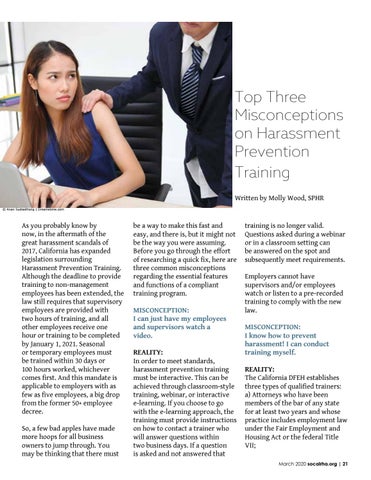Top Three Misconceptions on Harassment Prevention Training Written by Molly Wood, SPHR Š Anan Sudsaithong | Dreamstime.com
As you probably know by now, in the aftermath of the great harassment scandals of 2017, California has expanded legislation surrounding Harassment Prevention Training. Although the deadline to provide training to non-management employees has been extended, the law still requires that supervisory employees are provided with two hours of training, and all other employees receive one hour or training to be completed by January 1, 2021. Seasonal or temporary employees must be trained within 30 days or 100 hours worked, whichever comes first. And this mandate is applicable to employers with as few as five employees, a big drop from the former 50+ employee decree. So, a few bad apples have made more hoops for all business owners to jump through. You may be thinking that there must
be a way to make this fast and easy, and there is, but it might not be the way you were assuming. Before you go through the effort of researching a quick fix, here are three common misconceptions regarding the essential features and functions of a compliant training program. MISCONCEPTION: I can just have my employees and supervisors watch a video. REALITY: In order to meet standards, harassment prevention training must be interactive. This can be achieved through classroom-style training, webinar, or interactive e-learning. If you choose to go with the e-learning approach, the training must provide instructions on how to contact a trainer who will answer questions within two business days. If a question is asked and not answered that
training is no longer valid. Questions asked during a webinar or in a classroom setting can be answered on the spot and subsequently meet requirements. Employers cannot have supervisors and/or employees watch or listen to a pre-recorded training to comply with the new law. MISCONCEPTION: I know how to prevent harassment! I can conduct training myself. REALITY: The California DFEH establishes three types of qualified trainers: a) Attorneys who have been members of the bar of any state for at least two years and whose practice includes employment law under the Fair Employment and Housing Act or the federal Title VII; March 2020 socalrha.org | 21
